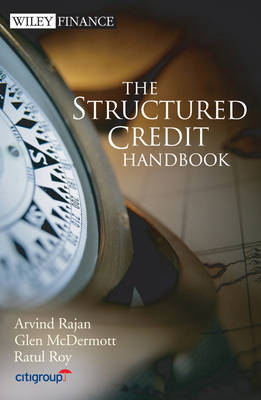
The Structured Credit Handbook
John Wiley & Sons Inc (Verlag)
978-0-471-74749-9 (ISBN)
The Structured Credit Handbook is a comprehensive introduction to all types of credit-linked financial instruments. This book provides state-of-the-art primers on single tranche collateralized debt obligations (CDOs), collateralized loan obligations (CLOs), credit derivatives (such as credit default swaps and swaptions), and iBoxx indexes. Filled with in-depth insight and expert advice, The Structured Credit Handbook covers all aspects of the synthetic arbitrage CDO market, including new instruments such as CDO2. Readers will also gain a firm understanding of the investment rationale, risks, and rewards associated with CDO investments through this valuable resource. The exploding use of credit derivatives and collateralized debt obligations (CDOs) has transformed the world of credit, creating an $18 trillion market almost overnight and resulting in innumerable investment and career opportunities globally. The Structured Credit Handbook provides the reader with a comprehensive and clear roadmap to today's new credit landscape. The full spectrum of structured credit products, from single-name CDS to CDOs, is explained in a simple, clear fashion that is free from the financial jargon and mathematical complexity which characterize many other derivative texts. The handbook begins with an in-depth explanation of the building blocks of the structured credit markets, single-name default swaps and indexes, and it culminates with complex products such as credit options, synthetic tranches, CDOs based on bank loans and asset-backed securities, and CDO-squareds.
Written by experienced practitioners who have participated in this market since its infancy, each of the thirteen chapters introduces and analyzes a new product and explains its practical applications. A rich set of real-life case studies illustrate the application of each product in a concrete market setting. The book may be used in a semester-long course on structured credit as part of a business or finance curriculum. Whether you are a market professional, a university student or faculty member, or simply a financially savvy layperson, look no further for an up-to-date and thorough introduction to this rapidly growing and exciting field.
Dr. Arvind Rajan, Managing Director, Citigroup Global Markets, is engaged in proprietary trading of Structured Credit products, and until recently, was global head of Structured Credit Research and Strategy at Citigroup. Glen McDermott (New York, NY) is Director of Fixed Income Sales and the former head of CDO Research at Citigroup Global Markets Inc. Ratul Roy is head of CDO Strategy for Citigroup Global Markets and has spent the prior nine years in structuring or analyzing CDOs and other structured credit products.
ARVIND RAJAN, PHD, is a Managing Director at Citigroup, where he engages in proprietary trading of credit, structured credit, and emerging markets. He was previously co-head of U.S. Fixed Income Strategy (20042005) and global head of Structured Credit Research and Strategy (20032005). Rajan was twice ranked first and once second in the All-America Fixed Income Research poll by Institutional Investor magazine. He has more than two decades of experience in modeling and quantitative analysis. GLEN MCDERMOTT, JD, is a Director in the Structured Credit Sales Group at Citigroup Global Markets. Previously, McDermott was a highly ranked research analyst and global head of CDO Research and Strategy at Citigroup for five years (20002005). Prior to joining Citigroup, McDermott worked for six years (19942000) at Standard & Poor's Ratings Services where he analyzed many structured finance asset classes. McDermott's work has been published in numerous scholarly journals, and he is also a contributor to the Salomon Smith Barney Guide to Mortgage-Backed and Asset-Backed Securities, also published by Wiley. RATUL ROY is Head of CDO Strategy for Citigroup Global Markets. Before taking on his current role in 2005, Roy was head of European CDO Strategya position he occupied in 2003 after spending the prior seven years in structuring or analyzing CDOs and other structured credit products. This included positions in UBS Capital Markets (19951997), Chase Manhattan Bank (19971999), Standard & Poor's (19992000), and finally, as a cash CDO structurer in Citigroup's London office (20002003). Roy holds a PhD in chemical engineering from Cambridge University, England.
Acknowledgments xix
About the Authors xxi
About the Contributors xxiii
Introduction: A Roadmap of the New World of Structured Credit 1
How Structured Credit Completes Markets 2
Enabling Technology 3
Improved Liquidity, Transparency, and Customizability 3
Growth of Structured Credit Markets 4
Asset Classes 4
Products 4
Participants 7
Core Uses of Structured Credit 8
Nonrecourse Leverage 8
Diversification 8
Customization of Risk Profiles 9
Separating Legal from Beneficial Ownership 9
Separating Funding from Risk Transfer 9
Isolating and Hedging Risk 10
Representative Examples of Structured Credit Solutions 10
Who Should Read This Book? 11
How This Book Is Organized 11
PART ONE Index and Single-Name Products
CHAPTER 1 A Primer on Credit Default Swaps 17
Arvind Rajan
The Market for Credit Default Swaps 17
Transaction Terminology and Mechanics 22
Prerequisites for Credit Derivatives Transactions 22
What Happens in Case of a Credit Event? 23
Unwinding Default Swap Transactions 25
The DV01 of a Credit Default Swap 25
The Default-Cash Basis 26
Some Uses of Default Swaps 26
Buying a Note versus Selling Default Protection 26
Freeing Up or Using Bank Credit Lines 27
Filling a Maturity Gap 28
Expressing Curve or Forward-Rate Views 28
Barbell-Bullet Trade 29
Taking Advantage of Tight Repo Levels without Financing 29
Case Study: Relative Value—Cashing In on the Curve Steepness in Telecoms 30
How to Blend CDs and Cash in Long-Maturity-Curve Trades 30
Implementing Credit Curve Flatteners—Two Basic Approaches 33
Appendix: Equivalence of a Bond Spread and Default Swap
Premium 35
Specialness of the Underlying 36
Effect of Accrued Default Swap Premium 36
Accrued Interest on the Underlying Risky Security 37
Accrued Interest on the Underlying Risk-Free
Security 37
CHAPTER 2 Credit Default Swaptions 39
Arvind Rajan and Terry Benzschawel
Payer Options 40
Example—When to Buy a Payer 41
Example—When to Sell a Payer 42
Receiver Options 42
Example—When to Buy a Receiver 43
Effect of DV01 on Credit Swaption Payoffs 43
Example—When to Sell a Receiver 44
Credit Swaption Payoffs in Default 46
Credit Swaption Implied Volatility 47
Conclusion 47
Case Study: Are Tight Spreads Giving You Butterflies? 49
Introduction 49
Float Like a Butterfly, Sting Like a Bee 50
Butterfly versus Payer 50
Variations 54
Details of Butterfly Construction 54
Conclusion 54
CHAPTER 3 Constant Maturity Credit Default Swaps 57
Olivier Renault and Ratul Roy
Basics of CMCDSs 57
Participation Rate 58
Behavior of CMCDSs 59
Impact of Spread Level 60
Impact of Spread Volatility 64
Capped CMCDS 66
Hedging CMCDSs 68
Trading Strategies with CMCDSs 69
Selling CMCDS Protection 69
Buying CMCDS Protection 70
Combination Trades and Index CMCDSs 70
Conclusion 72
Case Study: Taking Curve Views with CMCDSs 72
Features of CMCDSs 73
Trade Ideas 73
Appendix: Computing the Participation Rate 76
CHAPTER 4 Credit Derivatives Indexes 79
Jure Skarabot and Gaurav Bansal
Introduction 79
Family of Credit Derivatives Indexes 80
Structure of the CDX/iTraxx Index Family 81
Administration of Indexes 83
Basket of Credit Default Swaps 83
Trading Example—The Index 84
Up-Front and Running Payments 84
Trading Example—Premium Payments 85
What Happens in Case of a Credit Event? 86
Trading Example—Credit Event 87
Settlement Process after Credit Event 87
Physical Settlement (Indexes and Tranche Products) 88
Cash Settlement (Tranche Product Only) 88
Recent Defaults in CDX Indexes 88
Index versus Intrinsics 90
Investment Strategies with Credit Derivatives Indexes 91
Investors 92
Index-Related Structured Credit Products 92
Issues and Concerns 93
Conclusion 93
Case Study: DJ CDX HY and DJ CDX EM—Conversion of Price Level into a Spread Level 94
Case Study: Using iTraxx to Replicate Bond Portfolios 94
Motivation 94
Typical Portfolio Risks 95
Replicating Interest Rate Risks 96
Using iTraxx to Replicate Broad Credit Market Risk 96
Adjusting for Single-Name Risk through Default Swaps 99
Performance 100
Conclusion 104
Appendix: Description of the Roll Process 106
Risky PV01 of a CDS Contract 106
Calculation of Intrinsic Spread of the Index 107
Risky PV01 of an Index 108
Mark-to-Market Estimation of an Index Position 108
CHAPTER 5 The Added Dimensions of Credit—A Guide to Relative Value Trading 111
Matt King and Michael Sandigursky
Overview of Curve Trades 111
Learning Curves 112
Drivers of Curve Steepness 113
Putting on a Curve Trade 115
Cross-Currency Trades 116
Cross-Currency Opportunities in Bonds 117
Cross-Currency Trades in CDSs 117
Basis Trades 118
Back to Basis 118
Drivers of Basis 122
Why CDSs and Bonds Are Two Sides of the Same Coin 122
Trading the Basis 126
A New Spread Measure: C-Spread 129
Debt-Equity Trades 129
Meet the Models 129
The Debt-Equity Cycle 130
A Practical Hurdle or Two 131
Debt-Equity Trading in Practice—Arbitrage or Mirage? 132
Deciding What to Trade 133
A Recovery Trade 134
iTraxx Credit Indexes 134
Truly Global 135
You’ve Got to Roll with It 136
iTraxx Intrinsics 137
What Happens When a Name Defaults? 139
Equiweighted or Not 139
Second-Generation Products: iTraxx Tranches 139
Credit Options 140
It’s a Knockout 140
Effect of Convexity on Credit Option Payoffs 141
Delta-Exchange 143
Why Sell an Option (Riskier Strategy) Rather Than Buy One? 143
Option Strategies 144
PART TWO Portfolio Credit Derivatives
CHAPTER 6 Single-Tranche CDOs 149
Jure Skarabot, Ratul Roy, and Ji-Hoon Ryu
Overview of Single-Tranche CDOs 149
Advantages of Single-Tranche CDOs 150
Key Features of Single-Tranche CDO Transaction 150
Description of the Product and Basic Structure 151
Main Decision Steps for Investors 153
Key Issues in Modeling and Valuation 155
Single-Tranche CDO Risk Measures and Hedging 158
Substitution of Credits 164
Single-Tranche CDO Market 166
Investment Strategies 167
Case Study: Dispersion Trades and Tranches 180
Traditional Bull-Bear Trade 180
Not Just Another Bull-Bear Tranche Trade 181
Who’s Afraid of Blowups? 181
Buy Protection on 10-Year 3 to 7 Percent CDX IG Tranche, Sell Protection on 5-Year 10 to 15 Percent CDX IG Tranche 183
Effect of Blowups in CDX IG on the Dispersion Trade 184
Trade Sensitivity Analysis 184
How to Choose the Most Efficient Tranches 187
Conclusions 190
Case Study: Attractions of Hedged Mezzanines 190
Motivation 191
The Trade 191
Comparing Delta-Hedged Equity and Mezzanines 192
Time-Decay Profile 194
Conclusion 195
CHAPTER 7 Trading Credit Tranches: Taking Default Correlation out of the Black Box 197
Ratul Roy
The Credit Tranche Market 197
Importance of Default Correlation in Tranches 199
Problems with Traditional Correlation Measure 199
Skew in Default Correlation 201
Further Flaws in Tranche Correlation 201
Correlation Skew Is Like a Volatility Surface 201
Skew Is Market’s Risk Preference 204
Investor Risk Appetite May Scale Across Markets 207
Greeks: Managing Correlation and Delta Risk 209
In Summary: Why Skew Is a Better Model 213
Trading Opportunities for Investors 214
Tranche Correlation Can Still Provide Insight 214
Pricing Off-Market Tranches 217
Conclusion and Future Agenda 219
Case Study: Curve Trades in Tranche Markets 220
Curve Trades, Tranche Markets, and Technicals 220
Trade Recommendation 221
Market Drivers for the Tranche Curve Trades 221
Base Correlation Analysis and Market Technicals 223
Technicals Driving the Flattening of Tranche Curves 224
Analysis of Investment Strategy 225
CHAPTER 8 Understanding CDO-Squareds 229
Ratul Roy and Matt King
CDOs versus CDO2 230
Value of CDO2s Derives Broadly from Inner CDOs 232
CDO2 versus Inner CDO 234
Like Mezzanine, but with Tails 235
CDO2 versus Master CDO 236
Economic Value versus Rating Quality 238
Uses of CDO2: Long, Short, and Correlation! 239
Structures: Good, Bad, and Ugly 239
Inner CDO Tranche Seniority and Thinness 240
Overlap of Credits 242
Nonuniformity of Portfolios 243
Fungible and Tradable Subordination 244
How Managers Can Add Value 246
Not Just Credit Selection 246
Manage to the Structure 248
Conclusion 249
Case Study: Term Sheet 249
CHAPTER 9 CPPI: Leveraging and Deleveraging Credit 253
Olivier Renault
Product Mechanics 253
Managed CPPIs 256
When Is CPPI Suitable? 257
Choice of Trading Strategies 257
Case Study: Performance Comparison of Strategies 258
Baseline: Unlevered Strategies 258
Simulations 258
Results 259
Performance Comparison in CPPI Setup 263
Other Strategies 264
Appendix: Our Methodology 265
Our Estimations and Simulations 265
PART THREE Collateralized Debt Obligations
CHAPTER 10 Collateralized Loan Obligations 269
Glen McDermott, William E. Deitrick, Alexei Kroujiline, and Robert Mandery
Leveraged Loan Market Overview 270
Strong Primary Market Growth 270
Broadening Investor Base 272
Increasing Secondary Market Liquidity 273
Continuing Challenges to Loan Market Liquidity 275
Key Loan Characteristics 276
Loan Structures 281
Revolving Credit Facilities 281
Amortizing Term Loans 281
Institutional Term Loans 282
Pro Rata Loans 282
Overview 282
Key Characteristics 283
Investment Opportunities 284
Middle-Market Loans 285
Overview 285
Key Characteristics 285
Investment Opportunities 288
European Leveraged Loans 289
Overview 289
European Mezzanine Bank Loans 290
Key Characteristics 292
Investment Opportunities 292
Collateralized Loan Obligations 293
Efficient Access to Loan Market Investment
Opportunities—Introducing CLOs 293
Basic CLO Structure 293
CLO Asset Manager 296
CLO Market Today 297
Key Drivers of CLO Outperformance 298
Conclusion 303
Middle-Market CLO Handbook 303
Middle-Market Size and Definition 304
Growing Investor Demand 305
Dominance of Institutional Term-Loan Debt 305
Second-Lien Loans Emerge 306
Investment Considerations for Middle-Market Investors 307
Legal Considerations 312
Middle-Market CLOs 312
CLO Investment Considerations 320
Conclusion 324
Appendix A: Middle-Market Loan Characteristics 325
Floating-Rate Coupon 325
Maturity 325
Callability 326
Covenants 326
Structure of a Middle-Market Loan 326
Appendix B: The Basic CLO Structure 327
Case Study: CDO Combination Securities—Tailoring Risk/Return Profiles 329
Introduction 329
Equally Rated CDO Combination Securities Are Not Equal 330
Value in Baa3-Rated CLO Combination Securities 332
Conclusion 334
CHAPTER 11 ABS CDOs 335
Ratul Roy and Glen McDermott
Overview of the Structured Finance Market 335
Basic Structure 335
Roles of Multiple Parties in a Securitization 336
ABS Market Fundamentals 336
Major Characteristics of Structured Finance Securities 344
Relative Value 344
Structural Protection 346
Collateral Stability 346
Challenges 348
CDOs of Structured Finance Securities 350
Investor Motivation 350
A Customized Investment 350
Relative Value 351
Major Considerations in CDO Investing 351
Leveraging Stability—Performance of SF CDOs 354
CDOs of SFSs Take Many Forms 354
Conclusion 358
Case Study: Relative Value in High-Grade Structured Finance CDOs 358
Transaction Overview 359
High-Grade SF Securities: A Strong Track Record 361
Cash Flow Analysis 363
Conclusion 364
Case Study: Untangling Mezzanine and High-Grade Structured Finance CDOs 364
Collateral Composition 365
Collateral Risk 366
Expected Loss 366
Correlation Views 368
Other Differences 368
Conclusion 369
Appendix: Rating Transition Matrices of Common
Structured Finance Collateral 369
CHAPTER 12 CDO Equity 371
Glen McDermott and Alexei Kroujiline
Cash Flow CDO Income Notes 373
Return Analysis 377
Defaults 378
Recoveries 380
Interest Rate Risk 382
Collateral Manager 384
Collateral Manager Review 384
Asset Selection 385
CDO Investment Guidelines 386
CDO Manager Types 388
Investment and Trading Philosophy 389
Asset Characteristics 391
Collateral Mix 391
Time Stamp or Cohort 392
Diversification 393
Structure 394
Trigger Levels 394
Senior Costs, Swaps, and Caps 395
Manager Fees and Equity Ownership 396
Credit-Improved Sales—Treatment of Premium 396
Conclusion 397
Case Study: Diversifying Credit Risk Using a CDO Equity Fund 397
Introduction 397
Modeling Assumptions and Analytical Techniques 398
Results 399
Conclusion 400
CHAPTER 13 Commercial Real Estate CDOs 403
Darrell Wheeler and Ratul Roy
CRE CDOs by the Numbers 403
Slow Start, but Growth Now Strong 403
Relative Value: Spread Pickup Often Gives CRE CDOs an Edge 405
CRE CDO Performance Has Been Strong 406
Collateral Mix: Diverse and Evolving 407
Building Blocks of a CRE CDO 409
B-Notes and Rake Bonds 411
Second Lien Loans 412
Mezzanine Loans 412
Preferred Equity 413
Whole Loans 413
CMBS First Loss Positions or B-Pieces 413
CRE CDO Managers and Sponsors 415
Who’s Who 415
What to Look for in a CRE CDO Manager 415
CRE CDO Investors: A Diverse Group 416
Key Events in the CRE CDO Market 417
A Market Is Born 417
The Rise of CRE CDOs as a Source of Financing 418
The Push for Flexibility 420
The Current State of the CRE CDO Market 421
Investor Analysis of CRE CDOs 422
CRE CDO Analysis for Traditional
CDO Investors 423
CRE CDO Analysis for Traditional
Real Estate Investors 423
Additional Suggested Collateral Analysis 428
Analysis of CMBS Certificates 428
Analysis of Uncertificated Securities 429
Appendix: List of CRE CDOs 432
Glossary 437
Term Sheet 439
Notes 443
Index 457
| Erscheint lt. Verlag | 2.3.2007 |
|---|---|
| Reihe/Serie | Wiley Finance |
| Zusatzinfo | Drawings: 199 B&W, 0 Color; Screen captures: 2 B&W, 0 Color; Tables: 105 B&W, 0 Color |
| Verlagsort | New York |
| Sprache | englisch |
| Maße | 160 x 236 mm |
| Gewicht | 730 g |
| Themenwelt | Betriebswirtschaft / Management ► Spezielle Betriebswirtschaftslehre ► Bankbetriebslehre |
| ISBN-10 | 0-471-74749-1 / 0471747491 |
| ISBN-13 | 978-0-471-74749-9 / 9780471747499 |
| Zustand | Neuware |
| Haben Sie eine Frage zum Produkt? |
aus dem Bereich


